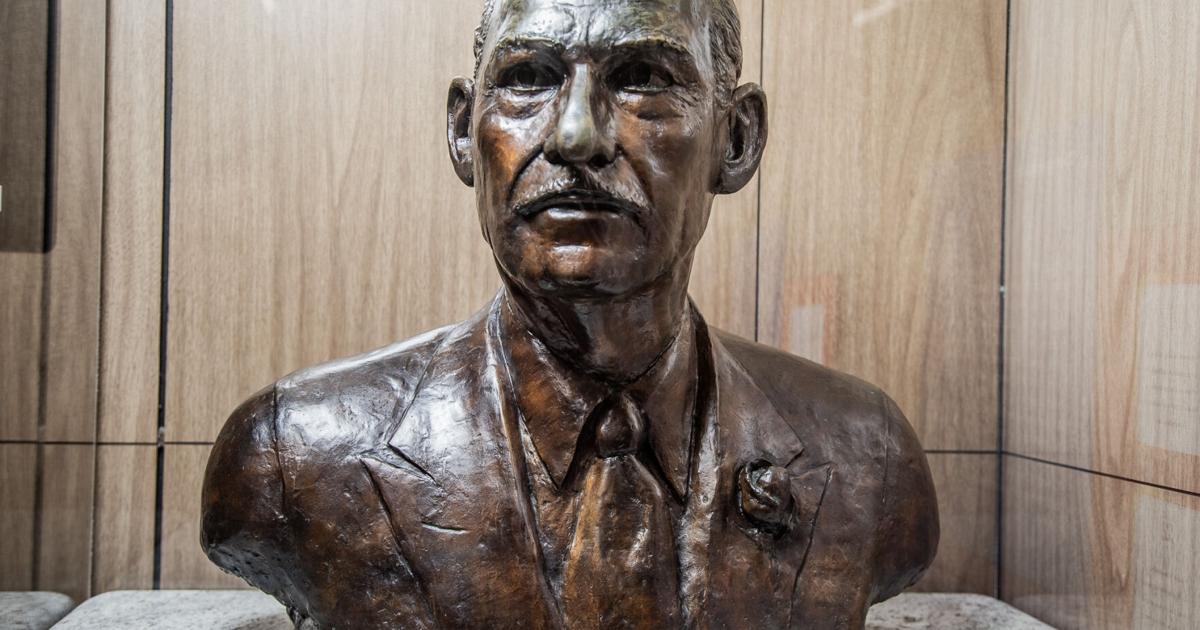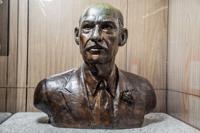The bust of Ernest H. Hereford sits on the third floor of the Central Library on Sept. 22. The bust was recently relocated.
For years, the bronze bust of former UTA President Ernest H. Hereford sat just inside the south entrance of the University Center, a building named after him.
Not anymore.
A recent relocation caught students off guard, and some took their surprise to social media. For many years, students have shared a collective memory of rubbing the bust for good luck.
The bust now rests inside a glass encasement on the third-floor staircase of the Central Library as part of the “UTA: Growth and Transformation” exhibit, which showcases 130 years of the university’s history and evolution.
The relocation marks Hereford’s legacy within a broader historical context, said Joe Carpenter, UTA chief communications officer.
It’s a decision long in the works; it comes after years of research, student activism and administrative deliberation — a slow, sometimes stalled process that ended only recently.
For about seven years, students held demonstrations and met with university leaders to bring up objections to alleged racist behaviors at the university during Hereford’s tenure.
“My perspective was always that obviously he played a important role in shaping the university as it existed,” said Dylan Buck, former Student Body vice president. “However, that doesn’t necessarily mean that we should honor his memory in a way that is without the context of that extra history that coincides with it.”
In 2023, Buck authored Resolution 23-06, “Removal of E. H. Hereford’s Bust from the UC,” asking for it to be placed in the Central Library’s Special Collections. He introduced it after a resolution calling for a referendum to both remove Hereford’s namesake from the building and relocate the bust was killed twice during a Student Senate meeting.
Hereford served as president of UTA, then known as Arlington State College, from 1949 until his death in 1958.
Throughout his tenure, he allegedly allowed multiple racist activities on campus, including blackface, allowing a student organization to operate under the name Kampus Kadet Klub and sanctioning the Confederate flag to be the university’s symbol.
“He kind of laid the groundwork to where a lot of the more infamous stuff, such as the mock slave auctions in the ’60s took place,” said Mark Napieralski, alumnus and former Progressive Student Union president.
Napieralski said that placing the bust at Special Collections frames it within the historical context of Hereford’s past actions rather than being a prop for school tradition and culture in the University Center.
In 2018, Napieralski began conducting preliminary research on the university, which led to him learning about Hereford’s legacy. Over the next few years, he led efforts to protest for the removal of the former president’s namesake and bust from the University Center.
However, progress on the Hereford resolution in the Student Senate was stalled. In December 2023, almost two years before the official relocation, President Jennifer Cowley announced that the bust would be moved to the Special Collections.
“At the end of the day, he’s not here to defend himself, but his actions and his legacy, the legacy that he actually left, will speak as to what type of man he was,” Napieralski said.
For some students, the move is just another step in the push to address UTA’s history, as the University Center is still under Hereford’s name.
“What this means to me personally is that it feels like a concrete thing that we can point to to show progress,” said Seraphine Pecson, civil engineering senior and Progressive Student Union president.
@tay._.sansom

